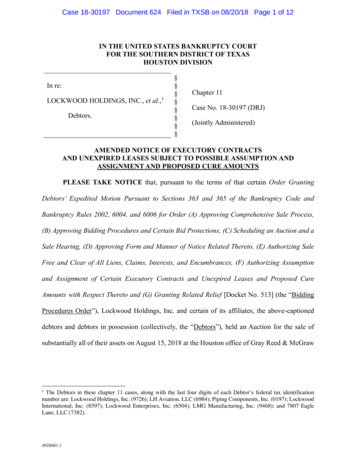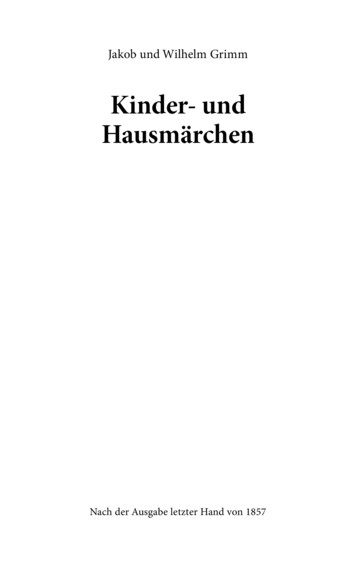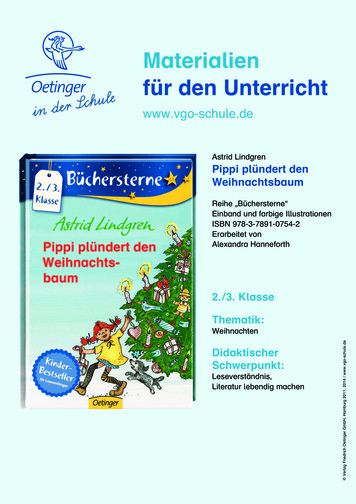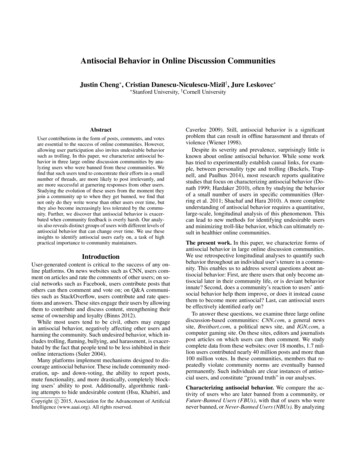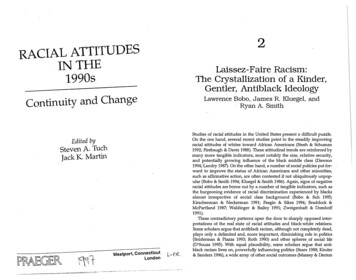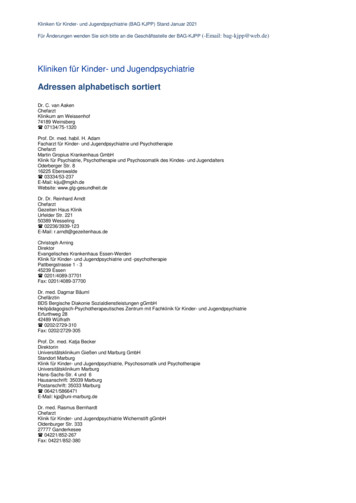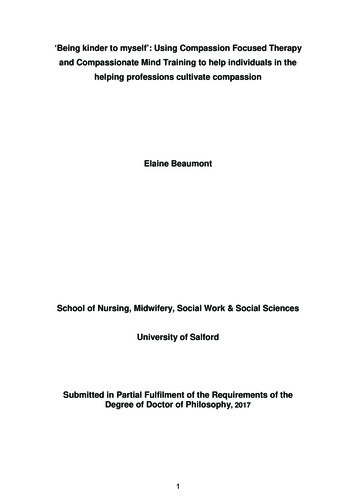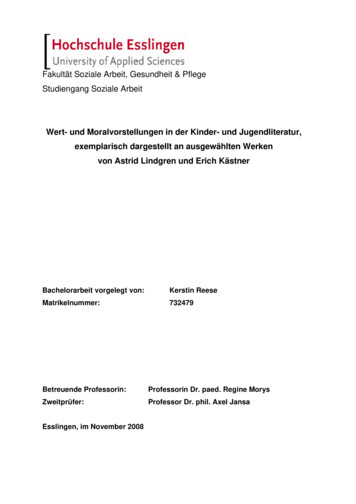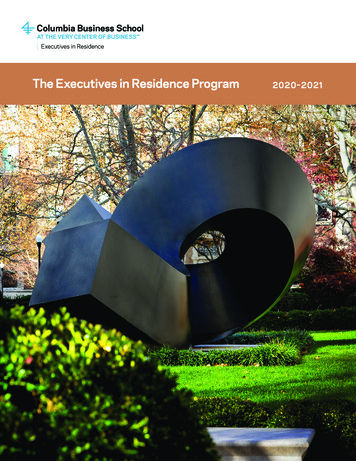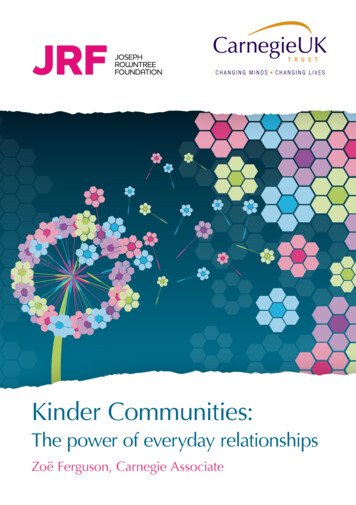
Transcription
Kinder Communities:The power of everyday relationshipsZoë Ferguson, Carnegie Associate
Kinder Communities: The power of everyday relationshipsEnabling WellbeingThoughtKinder Communities 2016ACKNOWLEDGEMENTSThis project has been established with the enthusiasm and support of too many to nameindividually. I would like to thank all those who took the time to talk to me to help guide myreading of relevant evidence and connect it to real lives. I have been genuinely surprised andgreatly heartened by the openness of parter organisations to take kindness seriously and thinkabout it in the context of their work. I am grateful for their collaboration, which is the basis ofthis project continuing. I am also grateful to the advisory group for their insight, support andchallenge. Finally, I am indebted to Martyn Evans and Jennifer Wallace of the Carnegie UKTrust for the opportunity of taking this work forward and their support in doing so.The text of this work is licensed underthe Creative Commons AttributionShareAlike 3.0 Unported License.To view a copy of this license / or send a letter to CreativeCommons, 444 Castro Street, Suite 900,Mountain View, California, 94041, USA.This report is printed onpaper that is FSC certified.
Kinder Communities: The power of everyday relationshipsContentsForeword11. Introduction32. What are we talking about?63. Why is this important?104. What do we know about enablers and barriers?155. What are we doing?216. Conclusions and next steps28Annex 1: Advisory Group34Annex 2: References35
Kinder Communities: The power of everyday relationshipsForewordTalking about kindness in a professional context does not sit comfortablywith many of us. On a personal level we fear getting involved in difficultsituations, of being asked to give too much or of being seen as needy. Formost policy makers it feels wholly uncomfortable and open to ridicule.However there is a growing body of evidence that consistently shows that positiverelationships and kindness are at the very heart of our wellbeing. This rings truein our own lives; it is so often our families and friends that bring us warmth andsupport, who are there in times of need. The absence of these relationships in ourown lives, and the lives of others, leads to isolation and loneliness.We are not alone in commenting on loneliness as one of the great ‘social evils’ ofour times. Modern social science has focused attention on social disengagementand on what can happen when solidarity is eroded. We are beginning tounderstand the costs of such erosion to society as a whole, as well as the costs tothe individual.Government, in all its guises, can be understandably reluctant to offer solutionsin such a personal aspect of our lives. It pulls us, knowingly or otherwise, towardsinstitutional solutions. To solutions focused on ever more paid professionalstaff and their organisations. The voluntary sector is a much caught up in this‘institution think’ as government. But a perceived lack of humanity is impingingon our trust in all these institutions and there are important questions about therole of organisations in reasserting basic values.This discussion paper is the start of a process, not the end. Over the comingmonths, we will be engaging directly with people who want to explore andtalk about kindness in their work, their lives and their communities. Our centralquestion is whether we should, and indeed could, do anything to encouragekinder communities?We will document our experiences and share them as widely as possible,believing that it is kindness, a sense of care for others, that binds us together. Bytalking more openly about the importance of kindness in our lives, we hope toencourage behaviours and activities that improve all our lives.Martyn EvansChief Executive, Carnegie UK TrustJulia UnwinChief Executive, Joseph Rowntree Foundation1
Kinder Communities: The power of everyday relationshipsPARTNERSHIP 1U-LABNoticing ‘not so random’ acts of kindnessOne of the key pieces of learningfrom the JRF Liveable Lives projectwas that the experience of takingpart in the research had a significantimpact on participants. They wereasked to keep journals logging allthe interactions involving giving orreceiving help and support. Manyreported that keeping a journaland just noticing, in many casessmall, acts of kindness gave themnew insight into their relationships.Some realised that they were moreconnected than they thought, othersthat the people they could rely onwere perhaps not the ones theywould have thought of immediately,some were giving without receivingor even in some cases they had nocontact with others at all.U-Lab is a massive open on-linecourse which aims to develop2people’s capacity to be changemakers. This involves encouragingthose not normally included toparticipate in developing holisticsolutions to cross sectoral challengesin modern life. The ScottishGovernment is supporting a newcohort beginning in September 2016.As part of the course participants willbe invited to take part in a ‘monthof joy’ in December. We aim toask participants to keep journalsduring this month logging the ‘notso random’ acts of kindness – thosewhich take place in the context ofconnections and neighbourhoodsand form relationships, and as suchare more laden with meaning andrisk than random acts.Participants will share insightsand hopefully take learning intoprototyping of projects.
Kinder Communities: The power of everyday relationships1. IntroductionThe Joseph Rowntree Foundation and Carnegie UK Trust both havea longstanding interest in evidence-based approaches to enablingand empowering communities in order to promote thriving placesand the wellbeing of individuals.JRF’s overarching mission is toachieve a prosperous, poverty-freeUK, while the Carnegie UK Trustseeks to improve the wellbeing ofthe people with particular regard tothose experiencing disadvantage.Carnegie UK Trust’s work on anenabling state has charted theshifting relationship between thestate and individuals and proposeda route map which would help thestate become an enabler, handingcommunities and individuals thepower to shape and contributeto their own wellbeing. JRF’sprogramme of research on risk, trustand relationships has investigatedhow everyday help and supporthappens in informal relationshipsbetween individuals and inneighbourhoods.This joint project brings thesestrands of work together to testa developing theory of changeon the importance of everydayrelationships and kindness incommunities. Partnerships arelimited to Scotland but approacheswill have wider applicability.Our hypothesis is that everydayrelationships and kindness arenecessary pre-requisites for othertypes of community activity, such asvolunteering and civic engagement.If our insights into how everydayrelationships work are applied bya variety of stakeholders, can thishelp to increase individual wellbeingand encourage community life toflourish?The project aims to:explore the evidence on theimpact of everyday relationshipsand kindness on individualand societal wellbeing, andcommunity empowerment;develop a theory of change withparticular attention on thosewho experience poverty anddisadvantage in society;3
Kinder Communities: The power of everyday relationshipstest the theory of change withdebate and deliberation amongstakeholders and the public;develop practical approaches forapplying the theory of change.This paper:sets out a rationale based onevidence;4proposes a theory of change;introduces 7 partnershipswhich aim to develop practicalapproaches to the theory ofchange; andsets out an approach tocapturing learning.A final report sharing learning willbe published in Spring 2017.
Kinder Communities: The power of everyday relationshipsPARTNERSHIP 2FOOD TRAIN FRIENDSPermission, shared valuesand boundariesThe exploration of evidence showedthat people often feel there is riskinvolved in engaging with othersand in giving or asking for helpwithin relationships. There is a riskof getting involved in a difficultsituation, of being asked to givetoo much, or of being perceived asneedy or even of being rebuffed.One of the JRF studies includeda comment from one participantwho said ‘why don’t you just go outand give an old lady like me a hugtoday’. On reflection, there are lotsof good reasons why people don’tbehave this way.ground rules for interaction. Theboundaries involved in Food TrainFriends befriending scheme areimportant in making people feelcomfortable that rules will not beoverstepped.Thinking about what would mitigatethe risk of engaging and either ofgiving or receiving help indicatesa number of factors. The first stepseems to be permission to engagein an increasingly individualisedsociety. Secondly having someshared values about the nature ofthe relationship seems important.Speaking to older people you oftenhear stories of neighbours helpingeach other in a way which goesbeyond what would be considerednormal behaviour nowadays. Peopleperhaps need to establish someThe practical approach involvesmaking the Food Train Friendsboundaries available to anyonein the community who wants tobe a ‘friend’. The aim is to see ifproviding light touch permission,values and boundaries encouragescomfort in connecting and ininteractions. ‘Friends’ wouldregister on the Food Train websiteor complete a simple form and‘pledge’ to support values and a fewsimple boundaries. We will followup with participants to exploreexperiences.5
Kinder Communities: The power of everyday relationships2. What are we talking about?The central notion of our hypothesis is that everyday relationshipsand kindness are important. The relationships and the kindness aredistinct and mutually reinforcing.Acts of kindness, as revealed bythe JRF work (Anderson, Brownlie& Milne, 2015), may be smallscale but nevertheless significant,occur between individuals in aninfrastructure where moral, orcultural, framing and reciprocityare important. We operate withina culture where we like to thinkof ourselves as kind to otherswhilst maintaining stoicism inthe face of our own difficulties.Broadly speaking, our sense ofdignity outweighs our comfort inrevealing vulnerability. Formingand maintaining connectionsand acting in kindness appearmundane but also difficult amongstthe challenges presented by life,particularly for those experiencingpoverty and disadvantage.This notion clearly refers to theconcept of social capital but webelieve is distinctive and worthexploring in its own right. Workon social capital tends to focus onthe nature of connections and theassets within civil society, definedas the space where people cometogether to pursue shared interests,enthusiasms and values (Hunjan,2010), or community (see Box 2).Box 1: Sen’s CapabilitiesWe can view this notion in the context of Sen’s capabilities framework(Brunner & Watson, 2015) where instead of focusing on resources suchas wealth or legal rights, the emphasis is on understanding what peopleare actually able to do and be through what Sen terms functionings andcapabilities. Functionings refer to states of the person or community,what they are able to do and what they are; things such as literacy, healthand mobility. Capabilities are real freedoms or opportunities – they arethe set of things people can do and can be. In this way connections arefunctionings and kindness a capability.6
Kinder Communities: The power of everyday relationshipsBox 2: Social CapitalDespite different definitions ofsocial capital, most appear tobe based on four key notions(Dodds, 2016):social trust and reciprocitycollective efficacyparticipation in voluntaryorganisationssocial integration andmutual benefitPutnam’s definitions ofbonding (tight relationshipsbetween homogeneousgroups), bridging (looserconnections between diversegroups) and linking (unequalrelationships to influenceand power) are familiar in agrowing recognition of theimportance of these typesof assets alongside moretraditional understandings ofcapital (Putnam, 2000)The space in which we see kindnesshappening is between individuals,albeit with both an influence anddependence on norms withincivil society or community. Ourhypothesis is that these interactionsof kindness between individualsunderpin community participationand a broader sense of social capitaland are worth considering in theirown right. An additional issue worthraising is that the concept of socialcapital can be seen as problematicbecause it implies that communitiesare disadvantaged as a result ofperceived deficits of networks andrelationships as opposed to the rootcauses of poverty and disadvantage(Collins, 2015). In our approach to thisproject we are clear that disadvantageimpacts negatively on social capitaland the root causes of structuralinequality must be tackled, but alsothat regardless of other factorssocial capital can be built and have apositive impact on communities.It is worth mentioning the growingmovement around random actsof kindness (for example nipun.servicespace.org) and again tomake a distinction. A number ofindividuals and organisations areadvocating ‘gifting’ for examplepaying the bill of the next person inthe queue at a cafe, and practicingsmall acts of kindness on a dailybasis as a way of both achievingindividual wellbeing and socialchange. What we are talking abouthere are perhaps ‘not so random’(Anderson & Brownlie, forthcoming)acts of kindness – the ones whichtake place in the context ofconnections and neighbourhoodsand form relationships. As suchthey are more laden with meaningand risk in execution.7
Kinder Communities: The power of everyday relationshipsBox 3: Isolation and lonelinessIsolation is the absence of social networks. Loneliness is the subjectiveexperience of isolation. The distinction is important. Being alone maybe a risk factor in loneliness but is not the same thing, just as havingrelationships does not guarantee escape from loneliness. Solitude can beenjoyed whereas loneliness is miserable. The Mental Health Foundationhave found that 42% of people have felt depressed because they werelonely and highlight loneliness as both cause and effect in mental healthproblems. Growing recognition of the impact of isolation and lonelinessis apparent in Scottish Government actions to set up a fund to tackleloneliness, a national summit and announcement of the intention todevelop a loneliness strategy in the programme for government.Other related, but again distinct,concepts worth mentioning areresilience, isolation and loneliness.Resilience, defined as the ability ofindividuals, places and populationsto withstand stress and challenge(Seaman, McNeice, Yates, &McLean, 2014) can be seen as an8expression of a virtuous circle ofconnections and kindness withincommunities. Growing concern andreference to isolation and loneliness(for example, Atrobus, 2014) can beseen as the opposite expression oflack of connections and kindness(see Box 3).
Kinder Communities: The power of everyday relationshipsPARTNERSHIP 3LINK UPShaping storiesLearning from Inspiring Scotland’sLink Up programme shows thatlack of social connections, low selfesteem and lack of confidence arefundamental barriers to individualchange and when these factorsare prevalent across a significantproportion of the community’spopulation that community’sability to look out for each other,to organise and effect largerscale change is inhibited. Link Upengages further upstream thanmany initiatives and concentrateson building new connections,developing confidence in socialsettings and working effectivelyin groups.Link Up has been active inHawkhill, Alloa over the last 4years. The Village StorytellingCentre is about to engagewith a cross section of thecommunity to create and sharestories which reflect their views,experiences and aspirations intheir community. In additionto producing a tangible record,it is also anticipated that theprocess will help forge improvedrelationships between communitymembers and act as a catalyst forincreased community participation.The initiative also provides anopportunity to observe some ofthe factors that appear importantfrom our evidence review. Storiesand myths are important insetting a context which in partinforms how people behave andwe are interested in how negativenarratives can be proactivelyturned around and what impactthat has on relationships withinthe community.9
Kinder Communities: The power of everyday relationships3. Why is this important?In order to help answer the question of what we could do toencourage kinder communities we made connections between theLiveable Lives study (Anderson, Brownlie & Milne, 2015), a reviewof related evidence (Haslewood, 2016) and wider (largely Scottishbased) sources.This was not a systematic review ofevidence but drew on discussionswith the advisory group (see Annex1), key stakeholders and communityrepresentatives and includestheir experience and insights inaddition to published sources. Theaim was to draw inferences fromconnections in relevant evidenceto build a rationale for a theory ofchange to suggest potentially newperspectives or approaches.The exploration of evidence showsthat everyday relationships andkindness are fundamental tothe wellbeing of individuals andcommunities. In an increasinglyvirtual world we still live in realhouses, on real streets and rely onreal people to make our lives work.In the context of growing isolationand loneliness (see Box 4), webelieve it is worth shining a light onthe infrastructure of connectionsand values which underpin ourrelationships, which remain largelyinvisible and taken for granted.10In addition to the contributionto wellbeing, the evidenceindicates that this infrastructure ofconnections and values underpinscommunity cohesion, participationand engagement. With increasingemphasis on genuine communityempowerment and welldocumented uneven confidenceto engage and participate acrosscommunities, we believe it isworth considering the potential toencourage kinder communities asa starting point in both increasingand levelling the capacity forcommunity empowerment. Weargue that whilst a discussion ofeveryday relationships and kindnessin neighbourhoods might onthe surface appear to have littlerelevance in the face of the urgencyof the challenges of austerity andincreasing inequality these conceptsare at the very heart of our abilityto generate wellbeing and thefoundations upon which the powerfor change can be built.
Kinder Communities: The power of everyday relationshipsBox 4: Increasing isolation and lonelinessA number of well understood shifts underpin increasing isolation andloneliness:an ageing population and an increase in single adult households –estimated to be the majority – 55% in Glasgow by 2037 (Dodds, 2016);increasing female participation in the labour market – positive inmany ways but as noted by Harrop, the Beveridge welfare state wasgrounded in the assumption that unpaid care in society was the roleof married women and as that becomes a historic relic how that careis replaced becomes an increasing challenge (Wallace, 2013);professionalisation of care. A feature of the way in which publicservices have developed has been our increasing focus onprofessionalism and concern with risk. Where neighbours, even whenthey did not have much, had a mentality of helping each other out,for example cooking for and sharing food we shifted to thinking thatcare e.g. food provided by a service would be better as we could besure it would meet hygiene standards etc.increasing individualism and atomisation of families as we are driven bysuccess at work, experience greater mobility in the labour market, andthe decline of faith groups;technology fueling ever busier lives and whilst in some contextsunderpinning connections in others adding to isolation e.g. textingreplacing a phone call or a visit (Telfer, 2015).WellbeingWe know relationships are crucialto wellbeing. There are welldocumented strong associationsbetween higher social capitaland lower mortality. A recentmeta analysis shows 26%, 29%and 32% increased likelihoodof mortality over an eight yearperiod, irrespective of age, dueto experience of loneliness,social isolation and living alone,respectively (Holt-Lunstad etal, 2015). Relationships impactsignificantly on physical and mentalhealth. The GoWell study finds thatresidents in 3 high rise estates inGlasgow often attribute healthproblems to adverse relationshipsand whilst they welcome changesin physical living conditions believeimproving relationships in theircommunity would have moreimpact (Egan & Lawson, 2012).11
Kinder Communities: The power of everyday relationshipsONS finds that personal wellbeing ishigher among individuals who knowand regularly talk to neighboursand that people’s satisfaction withwhere they live is more affected bygetting on with neighbours thanby quality of housing (ONS, 2015).The Canadian Index of Wellbeing(uwaterloo.ca), on the basis ofsignificant public engagement,identifies community as the mostimportant of eight domains ofwellbeing whilst in our own ScottishNational Performance Frameworkit has been recognised that we donot as yet have measures goodenough to reflect the importanceof connections in our communities.There is a growing recognitionthat wellbeing is a more relevantmeasure of progress in society thanGDP as we have seen diminishingreturns on increasing wealth onquality of lives in the post-industrialworld (Wallace & Schmueker, 2012).EmpowermentONS also identify positiverelationships with neighboursas playing an important role inimproving social cohesion, levels12of trust and feelings of belonging(ONS, 2015). As such they canbe seen as a pre-condition for anenabling state (Elvidge, 2014) ascommunity cohesion and socialparticipation underpin our abilityto realise key shifts from welfaredependency to genuine communityempowerment. It is important tohighlight that the concept of anenabling state is not one of a hollowstate which simply withdraws andleaves communities to get on withit and it recognises that there isan unequal confidence amongcommunities to create the powerfor change. The enabling state(Wallace, 2013) recognises cultureand values as a key factor in changealongside the fiscal challenge,intergenerational tensions andenvironmental limits to growth. Weare more likely to act in accordancewith dominant values than newinformation. One of the keychallenges of realising an enablingstate is in developing intrinsic values(such as community and caringfor each other) and the unequalconfidence to engage makes thisharder in some areas than others.
Kinder Communities: The power of everyday relationshipsDIAGRAM 1: WHY KINDNESS IS WELLBEINGEMPOWERMENT13
Kinder Communities: The power of everyday relationshipsPARTNERSHIP 4GLENAVON TENANTS ASSOCIATION (MARYHILL)A space outdoorsThe exploration of evidencehighlighted the importance ofthe nature of the places we haveto connect and interact in ourcommunities. Looking at theevidence suggests we shouldthink beyond the places we mightgenerally tend to think of and beaware of the potential for placeswhich include some, excludingothers, of stigma and the senseof comfort and safety differentmembers of the community willfeel in different places.In our meetings in Maryhillcommunity representatives notedthat often when they held eventsoutside they had much higherparticipation than events heldindoors. Speculating on why thatmight be, they felt that membersof the migrant community mightfeel more apprehensive about goingin somewhere they haven’t beenbefore. There might also be a senseof mistrust of public or voluntarysector run places as noted byArnade (Arnade, 8 June 2016).The tenant’s association recentlyupgraded the local park and thereare a number of picnic tables.14We thought it would be worthencouraging more use of thisspace drawing on the ideas of theimportance of outdoor space andsharing food.The tenant’s association willadvertise a regular picnic foranyone who wants to come alongto bring their own lunch andsomething to share if they feellike it. The aim is to see if, withvery little encouragement and nosense of provision or running byan organisation, you can generatecommunity spirit.
Kinder Communities: The power of everyday relationships4. What do we know aboutenablers and barriers?Looking at relevant evidence we sought to understand whatfactors might enable or inhibit forming and maintaining everydayrelationships and the capacity to act in kindness.They fell in three broad areas:structural inequality; history andculture and individual experience.What is important to note inconsidering this evidence is thatwhilst there are factors relating tothe relative disadvantage of wherewe live, distinctive histories and ourown biographies which shape thenature of our neighbourhoods, itdoes appear that communities canhave very different infrastructures,values and atmospheres in verysimilar conditions. This evidencechimes with the experience offunders. The Lloyds TSB Foundationfor Scotland (the Foundation) inpartnership with other charitablefunders has identified ‘cold spots’ intake up of funding for communityactivities. Areas of similardisadvantage and need differ in their‘energy’ in accessing funds. Based onthe above analysis we might assumethat it might therefore be possibleto encourage infrastructures, valuesand atmospheres which are betterfor individual and communitywellbeing and empowerment.Structural inequalityIt is well understood that povertyand disadvantage impact on levelsof social capital. It is commonsense that poor housing and thecost of leisure inhibit making andmaintaining relationships (Dodds,2016). The geographic separation ofindividuals and families experiencingpoverty, concentrate disadvantageand stigma with the result thatpeople living in the least deprivedareas are almost twice as likely tosay that most people can be trustedcompared with people in the mostdeprived areas (61% and 34%respectively, Social Attitudes Survey,2013). Other types of inequalityimpact on both the ability to makeand maintain relationships and thenature of resulting isolation andloneliness. For example: differencesin male and female experience;migrants; young people; lone parentsand older people. Notwithstandingthe clear impacts of inequality onsocial capital it does not explain allvariation. JRF research has pointedto a need for a more nuanced15
Kinder Communities: The power of everyday relationshipsunderstanding of the differencesbetween neighbourhoods that onthe surface appear similar in termsof deprivation indices (Batty & Cole,2010). They suggest that housing,transport and labour markets canmake qualitative differences. TheGCPH study of excess mortalityin Glasgow (Walsh, McCartney,Collins, Taubault, & Batty, 2016) hasalso found deeply political reasonsfor differences, concluding thatdecisions to ‘skim the cream’ ofthe city’s population to rehouse it’s‘best’ citizens in new towns left thecity with ‘the old, the very poor andalmost unemployable’ and a legacyof premature death.History and cultureThe GCPH three cities study(Seaman & Edgar, 2015) furtherexplored differences in social capitalin areas of similar socio economiccircumstances, looking at:psychological outlook, forexample aspirations andpreference for immediate ordelayed gratificationindividualismfamily life, for exampleexperience of family break upsocial mobilitydistribution and form of networklinks.16The findings highlight differenceswhich in part can be linked todistinctive experiences (for exampledeindustrialisation has beenexperienced in different ways,leading to greater geographicseparation from employmentopportunities in Glasgow) anddefining events which shape thehistory of a city (for example theHillsborough tragedy is seen asinstrumental in forming strongsocial solidarity across class dividesin Liverpool). Distinctive historiesshape cultural and moral framingsin communities.Social media is recognisedas an important element ofcurrent context influencing howrelationships are formed andmaintained. It can play a positiverole in increasing connections in‘the isolation of urban sprawl’(Tufekci, 2012). Evidence doesnot suggest a replacement of onetype of conversation (offline) withanother (online), rather that peoplewho use social media are eitheralso more social offline or havebenefitted from social media toconnect with people they otherwisewould not have found. Keepingin touch with family and friendsis among the main reasons forgoing online cited by people in
Kinder Communities: The power of everyday relationshipsGlasgow (White, 2013). However,our discussions also highlightedconcern with the way in which socialmedia is used when relationshipsare not working – for examplewhen neighbours are in dispute,the detachment of the mediumoffering cover or making it easyto vent aggression, exacerbatingcommunity relationships. Whilst ourprimary focus is on real life, proximalrelationships, we will seek to explorethe role of social media in helpingor indeed hindering kindness incommunities.Individual experienceIndividuals experience and respondto circumstances in different ways.Resilience literature (Seaman,McNeice, Yates, & McLean, 2014)highlights key characteristics ofresilient individuals as: havingat least one strong emotionalattachment; access to widersupport; positive communityexperiences and disposition. TheLiveable Lives stories (Anderson,Brownlie and Milne, 2015) showthat ‘disposition’ rather than beingan inherent quality is at least in partshaped by individual biography.The GCPH pSoBid study (GlasgowCentre for Population Health, 2013)has shown that, for those in morefavourable circumstances, healthoutcomes are better regardlessof personality characteristics.However, for those in more deprivedcircumstances, personality traits aresignificant and important predictorsof mental wellbeing and healthrelated
of joy’ in December. We aim to ask participants to keep journals during this month logging the ‘not so random’ acts of kindness – those which take place in the context of connections and neighbourhoods and form relationships, and as such are more laden with meaning an
